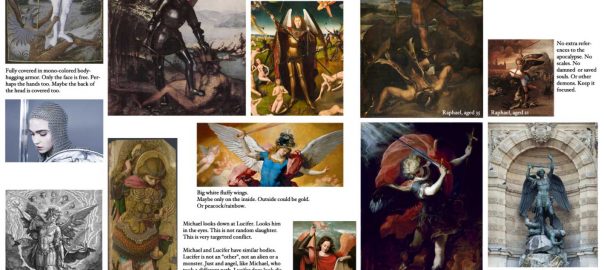The central event of this week’s work on The Synthetic Image was a visit to the Louvre museum in Paris. Intended to study the two paintings of Archangel Michael by Raphael, the hours spent roaming the endless museum halls also inspired a great many ideas. More about that here.
To prepare for the visit I read up a bit about Raphael’s life and work. I discovered how 16th century art historian Giorgio Vasari deeply idolized the painter for his politeness and friendliness. In stark contrast to contemporary colleague Michelangelo, apparently: “Nature created Michelangelo Buonarroti to excel and conquer in art, but Raphael to excel in art and in manners also.”
This renewed encounter with the high renaissance did however make clear that, despite of my deep enjoyment of this and later art, what I am hoping to approach in The Synthetic Image is only really present in earlier art. Sadly the museum rooms dedicated to the Northern Renaissance were closed for restoration. And the Louvre only has a few pieces by Southerners (Crivelli and Botticelli) that help my research.
In terms of actual work, I continued my tutorial in Blender with the basic modeling of a face. And while I do learn about some handy modeling features, the tracing of photographs in this tutorial seems to counter the anti-photography stance of my project. I do learn techniques but the tutorial doesn’t help with more technical aspects of either mesh construction or human anatomy.
The day after the visit to the Louvre, I was still exhausted from the trip. So i didn’t get much done. Something to keep in mind for future journeys!
On Friday I had planned to work some more on the diorama prototype. But since I didn’t want to work with Unreal’s standard mannequin character, I looked into an add-on for Blender called Manuel Bastioni Lab. This application can generate human bodies based on given parameters, including a poseable rig. It’s very impressive software but the choice between heroic, realistic and anime styles doesn’t make it suitable for my needs. The models are also far too detailed for my current prototyping needs.
I decided I should model some figures myself. Confronted with the empty startup scene in Blender, however, I felt at a bit of a loss on how to start. So I did a tutorial for modeling a very basic human figure. I ended up having quite a bit of fun modeling the shape better than in the tutorial. But I also realized that I lack some basic knowledge about the form of the human body. So I decided I need to study that a bit. I don’t want to learn actual human anatomy for fear that I would lose the naivety that I share with the early renaissance painters. So I started collecting screenshots of low poly meshes to sketch from.

And finally I worked on the design of the diorama and created a moodboard with decisions about scene, colors, clothing, etc. I realized that I can’t help being modern. No matter how much I admire the Old Masters, I keep having ideas that one would never find in their work, but that might appear in more recent art. Such as my desire to depict Lucifer as almost human, much like Michael. This is something that artists had only been doing since the baroque. In earlier art, Lucifer is always depicted as a grotesque monster. Indeed one can see this evolution in Raphael’s own work: his early Lucifer resembles a dragon, the later one a satyr.
Sadly I didn’t get around to prototyping the design. Looking forward to doing that next month!
— Michaël Samyn.

I’m very partial to a Michael in all-black. Not necessarily armor. If I were doing it the clothing would be very basic, something like a smock. I could explain why, but maybe my explanation would not be in keeping with the period you’re interested in replicating.
I also do not think Satan under foot is an interesting motif. It’s recognizable. But would Michael really trample Satan? Is Michael so brutal and humiliating? Is that the highest image we are able to aspire to today? It seems very fascist too.
I don’t look at these scenes as representations of real events. For me they are highly symbolic. The Archangel Michael is a symbolic warrior. As such, he would most certainly exhibit violent behavior. This “happened” long before fascism. Or long after, in the case of the Apocalypse. It is certainly elevated to the -highest degree- above any mundane politics or even war.
It’s a mythical scene for me that is inspiring for its meaning. For me Michael battling Lucifer is about how I need to fight my own evil urges, and extrapolated, mankind theirs.